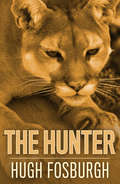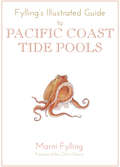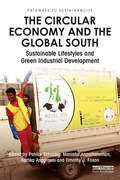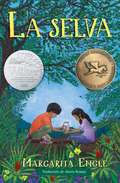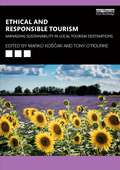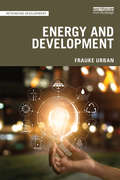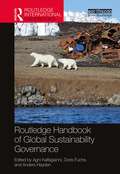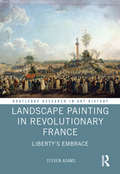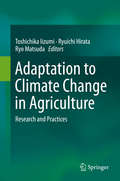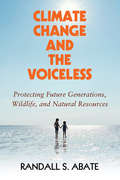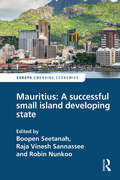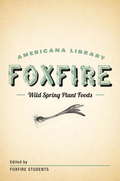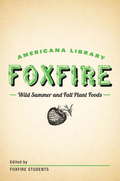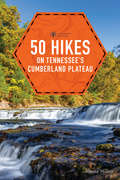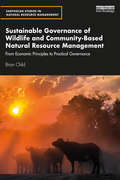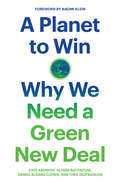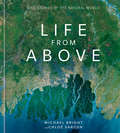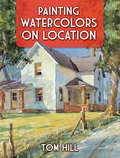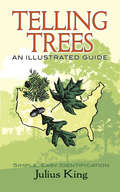- Table View
- List View
The Hunter
by Hugh FosburghThe Hunter, first published in 1950, is a lean novel in the Hemingway tradition that captures the essence of the big-game hunt. Set in the southern Rocky Mountains, the book focuses on Monk Taylor, living in semi-isolation with Billy Trott, a native, and a half-crazed old woman, only lives to track big-game while avoiding obligations to others, including the woman, Marge, who loves him. Monk agrees to guide two easterners on a lion hunt, but in a fit of rudeness, Monk ends the hunt but is soon himself lying injured and horseless in a gully. Saved, and brought back to Marge by Billy Trott, Monk fantasizes about marriage, but when he realizes he has nothing to give her or anyone else, he once again sends her away.
Fylling's Illustrated Guide to Pacific Coast Tide Pools (Fylling's Illustrated Guides #1)
by Marni FyllingThis scientifically accurate yet utterly charming field guide to the Pacific coast intertidal zone introduces readers to a world populated by spectacular wildlife: 150-year-old giant green anemones that paralyze their prey with their petal-like tentacles; sunflower sea stars that traverse the tide pool floor on twenty-four limbs; orange-tipped, opalescent sea slugs that dabble in cannibalism; and much, much more. Small enough to fit in a back pocket during a beach hike, the guide contains concise descriptions of tide pools' most common residents, noting each organism's size and zonation, as well as a few of its fascinating (and sometimes grotesque) habits. Full-color illustrations reminiscent of prints by Ernst Haeckel help tide poolers with easy identification.
The Circular Economy and the Global South: Sustainable Lifestyles and Green Industrial Development (Pathways to Sustainability)
by Patrick Schröder Manisha Anantharaman Kartika Anggraeni Timothy FoxonThe circular economy is a policy approach and business strategy that aims to improve resource productivity, promote sustainable consumption and production and reduce environmental impacts. This book examines the relevance of the circular economy in the context of developing countries, something which to date is little understood. This volume highlights examples of circular economy practices in developing country contexts in relation to small and medium enterprises (SMEs), informal sector recycling and national policy approaches. It examines a broad range of case studies, including Argentina, Brazil, China, Colombia, India, Indonesia, Kenya, South Africa, and Thailand, and illustrates how the circular economy can be used as a new lens and possible solution to cross-cutting development issues of pollution and waste, employment, health, urbanisation and green industrialisation. In addition to more technical and policy oriented contributions, the book also critically discusses existing narratives and pathways of the circular economy in the global North and South, and how these differ or possibly even conflict with each other. Finally, the book critically examines under what conditions the circular economy will be able to reduce global inequalities and promote human development in the context of the Sustainable Development Goals. Presenting a unique social sciences perspective on the circular economy discourse, this book is relevant to students and scholars studying sustainability in economics, business studies, environmental politics and development studies.
La selva (Forest World)
by Margarita EngleNow in Spanish, award-winning author Margarita Engle’s lively middle grade novel in verse about a Cuban-American boy who visits his family’s village in Cuba for the first time—and meets a sister he didn’t know he had. <P><P>Edver isn’t happy about being shipped off to Cuba to visit the father he barely knows. Yet now that travel laws have changed and it’s a lot easier for divided families to be reunited, his mom thinks it's time for some father-son bonding. <P><P>Edver doesn’t know what this summer has in store, but he’s definitely not expecting to meet a sister he didn’t know existed! Luza is a year older and excited to see her little brother, until she realizes how different their lives have been. Looking for anything they might have in common, they sneak onto the internet—and accidentally catch the interest of a dangerous wildlife poacher. Edver has fought plenty of villains in video games. Now, to save the Cuban jungle they love, he and Luza are going to have to find a way to conquer a real villain! <P><P>A Edver no le hace ninguna gracia que lo envíen a Cuba a ver al padre que apenas conoce. Sin embargo, ahora que las leyes de viaje han cambiado y es mucho más fácil reunir a las familias divididas, su mamá piensa que es hora de que padre e hijo pasen tiempo juntos. Edver no se imagina lo que le depara el verano, ¡pero definitivamente no espera conocer a la hermana que ni siquiera sabía que existía! <P><P>Luza es un año mayor y está muy entusiasmada por conocer a su hermanito, hasta que se da cuenta de cuán diferentes han sido sus vidas. A la busca de cualquier cosa que puedan tener en común, se meten en internet y accidentalmente atraen la atención de un peligroso cazador de animales salvajes. Edver ha luchado contra muchísimos villanos en los videojuegos. <P><P>Ahora, para salvar la selva que tanto quieren, ¡Luza y él tendrán que encontrar un modo de derrotar a un villano real!
Ethical and Responsible Tourism: Managing Sustainability in Local Tourism Destinations
by Tony O'Rourke Marko Kos AkEthical and Responsible Tourism explains the methods and practices used to manage the environmental impact of tourism on local communities and destinations. The three core themes of the book – destination management, environmental and social aspects of ethical sustainable development and business impacts – are discussed across both topic and case study chapters, alongside explanatory editorial analysis with all chapters clearly signposted and interlinked. The case studies address specific and practical examples from a global range of examples including sites in Australia, Central America, Europe Union countries, Japan, North America and South America. Used as a core textbook, the linking of theory in the topic chapters, and practice gained through case studies, alongside further reading and editorial commentary, Ethical and Responsible Tourism provides a detailed and comprehensive learning experience. Specific case studies can be used as standalone examples as part of a case teaching approach, and the editorial and discussion elements are designed to be suitable for those simply seeking a concise overview, such as tourism professionals or potential investors in sustainable tourism projects. This book will be essential reading for students, researchers and practitioners of tourism, environmental and sustainability studies.
Energy and Development (Rethinking Development)
by Frauke UrbanThis book explores the complex relationship between energy and development and discusses the core issues and concepts surrounding this growing area of research and policy. In the field of energy and development, the world faces two major challenges: (1) Providing energy access to the roughly one billion people worldwide who do not have access to electricity and the nearly three billion people worldwide who do not have access to clean cooking fuels; (2) achieving socioeconomic development while limiting global atmospheric temperature increases to 2 degrees Celsius to mitigate climate change. Taking stock of progress, Frauke Urban explores the key issues surrounding these goals and addresses the policy responses aimed at ending energy poverty and achieving sustainable development. She outlines various options for delivering energy access, analyses past and prospective energy transitions and examines the social, environmental, economic and technological implications of these possibilities. Taking a holistic and multi-disciplinary approach and containing useful teaching resources, Energy and Development provides a comprehensive overview of this complex field of study. This book will be a great resource for postgraduate and undergraduate students, scholars, practitioners and policymakers working in the fields of energy studies, international development, environmental studies, industrial engineering, as well as social sciences that relate to energy and development.
Routledge Handbook of Global Sustainability Governance (Routledge International Handbooks)
by Anders Hayden Agni Kalfagianni Doris FuchsThe Routledge Handbook of Global Sustainability Governance provides a state-of-the-art review of core debates and contributions that offer a more normative, critical, and transformatively aspirational view on global sustainability governance. In this landmark text, an international group of acclaimed scholars provides an overview of key analytical and normative perspectives, material and ideational structural barriers to sustainability transformation, and transformative strategies. Drawing on pivotal new and contemporary research, the volume highlights aspects to be considered and blind spots to be avoided when trying to understand and implement global sustainability governance. In this context, the authors of this book debunk many myths about all-too optimistic accounts of progress towards a sustainability transition. Simultaneously, they suggest approaches that have the potential for real sustainability transformation and systemic change, while acknowledging existing hurdles. The wide-ranging chapters in the collection are organised into four key parts: • Part 1: Conceptual lenses • Part 2: Ethics, principles, and debates • Part 3: Key challenges • Part 4: Transformative approaches This handbook will serve as an important resource for academics and practitioners working in the fields of sustainability governance and environmental politics.
Los Everglades de la Florida (¡Arriba la Lectura!, Level K #2)
by Kristin Cashore Denny BondNIMAC-sourced textbook
El poderoso roble (¡Arriba la Lectura!, Level J #1)
by Lisa Trumbauer Vicki JacobsonNIMAC-sourced textbook
Landscape Painting in Revolutionary France: Liberty's Embrace (Routledge Research in Art History)
by Steven AdamsThe French Revolution had a marked impact on the ways in which citizens saw the newly liberated spaces in which they now lived. Painting, gardening, cinematic displays of landscape, travel guides, public festivals, and tales of space flight and devilabduction each shaped citizens’ understanding of space. Through an exploration of landscape painting over some 40 years, Steven Adams examines the work of artists, critics and contemporary observers who have largely escaped art historical attention to show the importance of landscape as a means of crystallising national identity in a period of unprecedented political and social change.
Adaptation to Climate Change in Agriculture: Research and Practices
by Toshichika Iizumi Ryuichi Hirata Ryo MatsudaThis book highlights state-of-the-art research and practices for adaptation to climate change in food production systems (agriculture in particular) as observed in Japan and neighboring Asian countries. The main topics covered include the current scientific understanding of observed and projected climate change impacts on crop production and quality, modeling of autonomous and planned adaptation, and development of early warning and/or support systems for climate-related decision-making. Drawing on concrete real-world examples, the book provides readers with an essential overview of adaptation, from research to system development to practices, taking agriculture in Asia as the example. As such, it offers a valuable asset for all researchers and policymakers whose work involves adaptation planning, climate negotiations, and/or agricultural developments.
Climate Change and the Voiceless: Protecting Future Generations, Wildlife, and Natural Resources
by Randall S. AbateFuture generations, wildlife, and natural resources - collectively referred to as 'the voiceless' in this work - are the most vulnerable and least equipped populations to protect themselves from the impacts of global climate change. While domestic and international law protections are beginning to recognize rights and responsibilities that apply to the voiceless community, these legal developments have yet to be pursued in a collective manner and have not been considered together in the context of climate change and climate justice. In Climate Change and the Voiceless, Randall S. Abate identifies the common vulnerabilities of the voiceless in the Anthropocene era and demonstrates how the law, by incorporating principles of sustainable development, can evolve to protect their interests more effectively. This work should be read by anyone interested in how the law can be employed to mitigate the effects of climate change on those who stand to lose the most.
Mauritius: A successful Small Island Developing State (Europa Perspectives: Emerging Economies)
by Robin Nunkoo Boopen Seetanah Raja Vinesh SannasseeThe economic upturn and performance of Mauritius is a far cry from predictions made in the 1960s. The island’s remarkable economic performance since the 1980s can been attributed to a multitude of factors instrumental to the success of the economy, including structural reforms, outward looking export orientated strategies, diversification in the manufacturing, tourism and financial services sectors amongst others, sound economic governance and institutions, and significant investment in human capital. This book attempts to provide a detailed analysis of the various key ingredients which have helped to propel Mauritius to its current status. The various chapters provide important readings for both academics and policymakers, with the final chapter providing key policy strategies which the government needs to implement to help Mauritius graduate to the next level of development: namely to that of a high-income economy and, in moving out of the middle-income trap, laying the foundations for future growth and shared prosperity in the light of both domestic challenges and global constraints.
Wild Spring Plant Foods: The Foxfire AMericana Library (7) (The Foxfire Americana Library)
by Inc. Foxfire FundA handy illustrated guide to the edible plant life available in Appalachia and other temperate areas during the spring. From sassafras to rhubarb, each entry includes instructions on where to find the plant, how to spot it, and the ways it is best eaten, often with recipes. Plants include: MorelAsparagusWild onionWild garlic NettlesWild radishWhite mustardWater cressHorseradishChicoryWild lettuceDandelion
Wild Summer and Fall Plant Foods: The Foxfire Americana Library (8) (The Foxfire Americana Library)
by Inc. Foxfire FundA handy illustrated guide to the edible plant life available in Appalachia and surrounding areas during the summer and fall seasons. From berries to herbs perfect for teas and tonics, each entry includes information on where to find the plant, how to spot it, and the best ways to eat it, often with recipes. Plants include: GooseberriesRaspberriesBlueberriesFigsPawpawsCattailsNutgrassThistleCatnipSpearmintPeppermintBlue-mountain teaYarrowChamomile DillsBlack WalnutsPecansHazelnuts
50 Hikes on Tennessee's Cumberland Plateau: Walks, Hikes, And Backpacks From The Tennessee River Gorge To The Big South Fork (Explorer's 50 Hikes #0)
by Johnny MolloyWalks, hikes, and backpacking trips from the Tennessee River Gorge to the Big South Fork Tennessee’s Cumberland Plateau, a wide tableland cut with a dizzying array of deep gorges, is a geological wonderland. It is a place to behold and savor. This updated second edition covers hikes from the Big South Fork National River and Recreation Area near Kentucky to the fascinating Walls of Jericho astride the Alabama state line; from the thousand-foot gorge cut by the mighty Tennessee River down Chattanooga way to the watery beauty of Virgin Falls by Sparta. Specific emphasis is placed on the most scenic destinations and the unique places that make the plateau so special, places like the Great Stone Door, with its sandstone formations and vertical rock walls, and Cumberland Mountain State Park, with its ancient trees and evidence of ancient human history. Also included are comprehensive maps for each hike, scenic photos, and a hikes-at-a-glance table that makes choosing your desired hike a breeze.
Sustainable Governance of Wildlife and Community-Based Natural Resource Management: From Economic Principles to Practical Governance (Earthscan Studies in Natural Resource Management)
by Brian ChildThis book develops the Sustainable Governance Approach and the principles of Community-Based Natural Resource Management (CBNRM). It provides practical examples of successes and failures in implementation, and lessons about the economics and governance of wild resources with global application. CBNRM emerged in the 1980s, encouraging greater local participation to conserve and manage natural and wild resources in the face of increasing encroachment by agricultural and other forms of land use development. This book describes the institutional history of wildlife and the empirical transformation of the wildlife sector on private and communal land, particularly in southern Africa, to develop an alternative paradigm for governing wild resources. With the twin goals of addressing poverty and resource degradation in the world’s extensive agriculturally marginal areas, the author conceptualises this paradigm as the Sustainable Governance Approach, which integrates theories of proprietorship and rights, prices and economics, governance and scale, and adaptive learning. The author then discusses and defines CBNRM, a major subset of this approach. Interweaving theory and practice, he shows that the primary challenges facing CBNRM are the devolution of rights from the centre to marginal communities and the governance of these rights by communities, a challenge which is seldom recognised or addressed. He focuses on this shortcoming, extending and operationalising institutional theory, including Ostrom’s principles of collective action, within the context of cross-scale governance. Based on the author’s extensive experience this book will be key reading for students of natural resource management, sustainable land use, community forestry, conservation, and development. Providing practical but theoretically robust tools for implementing CBNRM it will also appeal to professionals and practitioners working in communities and in conservation and development.
A Planet to Win: Why We Need a Green New Deal (Jacobin)
by Kate Aronoff Alyssa Battistoni Daniel Aldana Cohen Thea RiofrancosIn the twenty-first century, all politics are climate politics.The age of climate gradualism is over, as unprecedented disasters are exacerbated by inequalities of race and class. We need profound, radical change. A Green New Deal can tackle the climate emergency and rampant inequality at the same time. Cutting carbon emissions while winning immediate gains for the many is the only way to build a movement strong enough to defeat big oil, big business, and the super-rich—starting right now.A Planet to Win explores the political potential and concrete first steps of a Green New Deal. It calls for dismantling the fossil fuel industry and building beautiful landscapes of renewable energy, guaranteeing climate-friendly work and no-carbon housing and free public transit. And it shows how a Green New Deal in the United States can strengthen climate justice movements worldwide. We don&’t make politics under conditions of our own choosing, and no one would choose this crisis. But crises also present opportunities. We stand on the brink of disaster—but also at the cusp of wondrous, transformative change.
Life from Above: Epic Stories of the Natural World
by Michael Bright Chloe SaroshWith over 200 spectacular images, including astonishing satellite photographs and stills from the PBS docuseries, Life from Above reveals our planet as you've never seen it before.Thanks to advanced satellite images, we can now see the earth's surface, its megastructures, weather patterns, and natural wonders in breathtaking detail. From the colors and patterns that make up our planet to the mass migrations and seismic changes that shape it, Life from Above sheds new light on the place we call home. It reveals the intimate stories behind the images, following herds of elephants crossing the plains of Africa and turtles traveling on ocean currents that are invisible unless seen from space. The true colors of our planet are revealed, from the striped tulip fields of Holland to the vivid turquoise lakes in Iceland to the green swirl of a plankton super bloom attracting a marine feeding frenzy. Whether it's the world's largest beaver dam--so remote it was discovered only through satellite imagery--or newly formed islands born from volcanic eruptions, you'll discover new perspectives with every image.
Painting Watercolors on Location
by Tom HillA comprehensive workshop approach presented by a master watercolorist, this guide features 11 step-by-step demonstrations filled with valuable methods and techniques for achieving striking on-site watercolor compositions. Beautiful examples and locations — including the Greek island of Santorini, a desert oasis, and a Midwest farmhouse — provide a wealth of inspiration as author and artist Tom Hill demonstrates how to paint intelligently, selectively edit a scene, and more.Painting Watercolors on Location shows developing artists not only how to acquire better understanding and techniques for painting on location but also how to incorporate these helpful practices into their everyday routines. Suitable for art students and artists at the intermediate level and up, these pointers include suggestions for choosing the correct on-site equipment, rendering accurate drawings, selecting and mixing colors, forming textures, and other methods for creating exciting and expressive watercolor paintings.
Telling Trees: An Illustrated Guide
by Julius KingWhat's the difference between an oak and a maple, a spruce and a pine, an ash and a sycamore? With this portable guide, you'll be able to distinguish between more than 100 common American trees. Take it along on walks and hikes for quick, accurate reference to brief, nontechnical descriptions and hundreds of illustrations.Each page features a map showing the tree's geographical range, and each illustration includes a background scale to help determine size. Leaves, needles, cones, flowers, fruit, and other details are clearly noted. Most trees are depicted in their full summer glory, but a key to identifying trees in winter is included, along with a helpful Index.
En la calle de las Praderas (¡Arriba la Lectura!, Read Aloud Module 7 #2)
by Henry ColeNIMAC-sourced textbook
